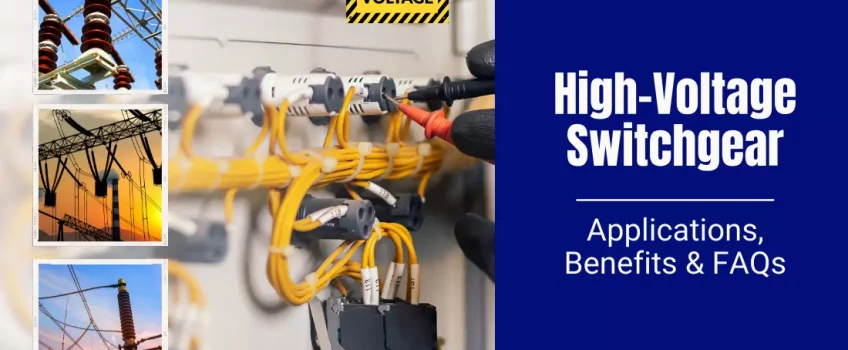
High-voltage switchgear is a type of electrical circuit protection equipment that protects, regulates, and separates electrical devices. The electrical components are housed in metal enclosures where a switchgear line-up or assembly refers to a group of one or more of these structures. Since PRV Engineering specialises in high-voltage switchgear, rail product and Oil & Gas industries, here is a summary of what it entails and how it works.
Types Of Electrical Switchgear Systems
There are three different types of electrical switchgear, namely low-voltage, medium-voltage, and high-voltage switchgear. To identify the best system for your needs, you have to match the design voltage to the voltage rating of the switchgear.
High-Voltage Switchgear (HV)
High-voltage switchgear controls 75KV of power or more and since these breakers are designed for high-voltage equipment, they often have better safety features.
Medium-Voltage Switchgear (MV)
Medium-voltage switchgear controls 1KV up to 75KV of power and is commonly found in systems such as motors, feeder circuits, generators, transmission and distribution lines.
Low-Voltage Switchgear (LV)
Low-voltage switchgear regulates systems up to 1KV and is often found on low-voltage power-distribution transformers and is used across several different types of industries.
Switchgear is common in electric utility transmission and distribution systems as well as medium to large commercial and industrial facilities. In North America, the IEEE standard is used, whereas, in Europe and other parts of the world, the IEC standard is utilised.
How Does Switchgear Work?
The function of high-voltage switchgear is to protect equipment from damage while providing an uninterrupted supply of power. It automatically closes the faulty circuit and disables the disrupted line, preventing equipment from being damaged while maintaining a continuous supply of electricity.
It is designed to de-energise to allow engineers to repair, test and perform maintenance. As such, switchgear boosts reliability by ensuring an uninterrupted power supply and a higher capacity of generating stations. This means that the system separates faulty sections of the circuit when there is a fault of some kind.
What Is The Difference Between Switchgear and Switchboards?
Whilst many use the terms interchangeably, switchgear and switchboards are not the same. Switchgear protects and controls the power supply but it also disconnects from a power supply when there is a fault in the system.
Switchboards, however, are only used to send power to other sources mostly in commercial settings. They also manage different voltage capacities where high-voltage switchgear can handle up to 350 kilovolts while most switchboards can only work with 600 volts.
In the event of a malfunction, the switchgear responds swiftly to prevent the damage from spreading into the remaining working parts. As such, electrical switchgear helps to prevent a complete circuit shutdown.
High-Voltage Switchgear And The Rail Industry
Rail switchgear, also known as switching equipment, is a type of high-voltage switchgear that is intended to safeguard and isolate railway electrical systems from the mains. In the case of an emergency, it delivers a quick, efficient, and organized shutdown of the electricity supply.
Typically, railway switchgear comprises two metal boxes: one for circuit breakers and the other for fuse holders. The switchgear is set on a concrete foundation and coupled to the track with metal rail clamps.
Rail switchgear can be used in either high or low-voltage applications. As you’d expect, high-voltage switchgear is used to switch high-voltage circuits and low-voltage switchgear for low-voltage circuits.
How PRV Engineering Started With High-Voltage Switchgear
Our first taste of the rail industry came about when Claverham needed help with a revolutionary set of electromechanical points they had developed. We looked at the design and added even further value to the product by engineering out extra costs where possible to make it more accessible and affordable to the rail industry.
The project was a huge success and met the desired goals with great effect. Since then, we’ve consistently been manufacturing components for their systems which are installed at over 800 locations. In addition to high-voltage switchgear, our Rail portfolio has grown which now includes the following:
- manufacturing for track, track laying and maintenance equipment
- contracts for supplying electrical connections, contacts and other rolling stock products to Transport for London and the Underground Rail Network
- Overhead line equipment with customers such as Brush, formerly Hawker Siddeley Switchgear, and we enjoy a successful alliance with the Rail Network and its suppliers
Why Choose PRV Engineering For High-Voltage Switchgear
Our high voltage switchgear meets and exceeds industry quality standards. Our team of experts conduct different tests to ensure the stability, reliability and functionality of our high-voltage switchgear. This includes mechanical tests, temperature tests and power frequency voltage.
At PRV Engineering, we always make sure our products comply with international standards. Whether you need high-voltage switchgear for power transmission, distribution equipment or any other projects, get in touch with us today.
Alternatively, visit our website for more information on our wide range of products and services, including high-voltage switchgear, busbars, site work, installation and maintenance, deep hole drilling and custom fabrication.


 Mail:
Mail: 



